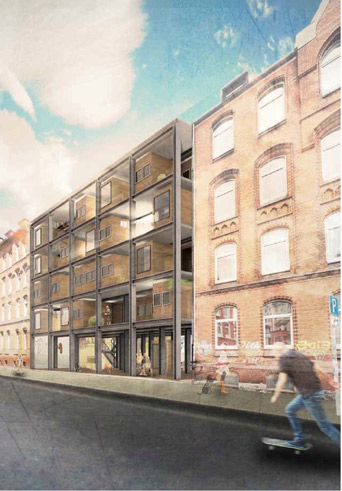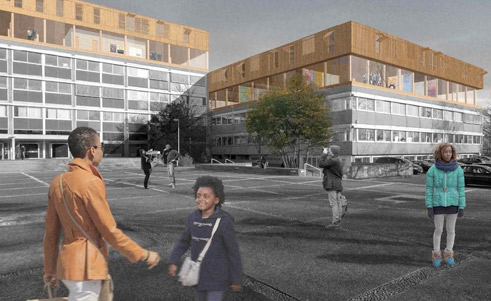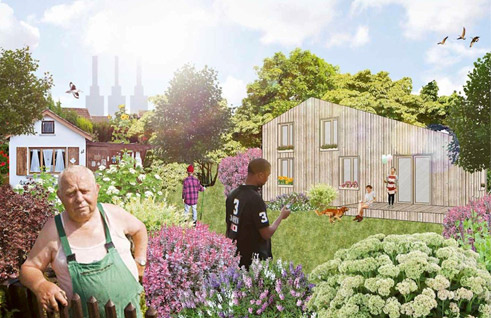Time to build it right
How new forms of urban living concepts can prevent past segregation problems to become the problems of the future
In 2015 alone, Germany registered 442.000 initial asylum requests. However, the number of asylum seekers that were registered in the EASY-System, which first registers asylum seekers before they can apply for asylum at the Federal Office for Migration and Refugees (BAMF), mount up to 1.1 million people. Some of these registrations are accounted for by double entries or by people who eventually seek asylum in other European countries. Nevertheless, it is apparent that the influx of refugees to Germany is enormous and at least a part of them will to stay for the long-run. One of the biggest organizational challenges in this regard is to organize housing for the thousands of people arriving on a monthly base. Many are first accommodated in preliminary emergency facilities such as gyms or converted office spaces.
Nonetheless, the even bigger problem manifests itself in long-term housing possibilities. After three months of stay, asylum seekers are not obliged to stay in the “initial reception accommodations” anymore. The influx of refugees stresses the already existing housing shortage in conurbation areas. According to official estimations, up to 400.000 new accommodation entities will need to be build each year up to 2020 to cover the demand for affordable housing. In 2015, only 260.000 accommodation facilities were built, leaving Germany with a social housing gap of 140.000 apartments. This huge number highlights the extensive failures and helplessness of German housing policy during the last years and implies a devastating reality to offer new prospects to asylum seekers.
Different measures and proposals for solutions have arisen to tackle the housing problem. Federal and State Governments intend to implement fiscal advantages to incentivize new construction in high cost areas and those areas with caps on rent increases. Furthermore, the amount of social housing, which has been significantly reduced since the early 90s, will be expanded and supported with significant budget increases. The precipitous building of social housing, however, is far from being the panacea for this problem. Indeed, premature housing solutions might evoke bigger problems in the future than they will solve in the present. Markus Reiter from the public radio broadcaster Deutschlandradio Kultur sees this challenge in turn as a catalyst to finally approach social housing problems from the past and learn from them for a better future. More living space needs to be created in conurbation areas – for both socially disadvantaged as well as high-income earners. Concentrated social housing areas from the 60s and 70s have in many cases developed into social hotspots. Social relegation and above-average rates of inhabitants with migration background led to the sealing off from majority society and eventually led to the creation of poverty ghettos in some cases. In order to fully integrate arriving refugees into German society, urban monocultures need to be broken down and social strata needs to be mixed: there is a need for social housing in bourgeois areas as well as apartments for high-income earners in more socially disadvantaged areas.
However, the central concern has drifted from finding suitable and central locations to finding any space at all where the large amount of refugees can be accommodated under the pressure of time. Exemplary is the city state of Hamburg, which is planning one of the most ambitious projects in terms of social housing: building 5.600 apartments for 28.000 asylum seekers spread over the seven districts of Hamburg until January 2017. The crux of the problem is that many big refugee accommodation centers as well as the newly planned buildings are and will be situation in already socially disadvantaged areas with high rates of unemployment, family breakdown and strong migration background. Even though it is planned to on the long-run also house students in these quarters, it is unknown whether the social mix will really occur. Having hundreds of young children from Syria, Iraq and Afghanistan grow up in such areas where they potentially cannot properly learn German, might repeat the problems connected to social housing of the past and make it impossible for neighborhood management to achieve social integration.
Nonetheless, there have been many creative building concepts based on urban postcompaction strategies in order to foster hybrid living forms counteracting the development of social segregation in cities. New concepts are mainly based on the following five strategies:
- Outbuilding of existing edifices
- Closing of curtilages of buildings
- Restructuring of existing areas
- Building of new edifices in large courtyards
- Conversion of unused buildings
Unfortunately, many creative solutions are restricted by legal requirements. Architect Arno Brandluber suggests, for example, a liberalization of the eaves height for the addition of new stories on existing buildings. This needs to be accompanied by a legal regulation that property owners can only add on in order to provide cheap housing. Regulation exemptions like this could efficiently lead to the mixture of social and cultural milieus fostering long-term urban sustainability. A study group led by architect Jörg Friedrich already developed an architectural concept to increase their faculty building by two floors offering new studio spaces for students as well as apartments for refugees.
The same group of students developed further easy to build, aesthetic and low-price concepts to reflect Germany’s “Willkommenskultur” (welcome culture) in a “Willkommensarchitektur” (welcome architecture). Among them, the concept “Fill the Gaps” which is based on the construction of modular shelf systems in the curtilages of buildings. The different housing modules, stairways and terraces can be fitted according to the needs of the inhabitants and can be rearranged for future student housing solutions for example. Other design ideas include the restructuring of unused parking lots, house boat systems or living concepts in garden plots as gardening can foster new forms of togetherness between refugees and local people – all centrally situation in order to prevent influx and segregation in the outskirts.
It is only to hope that Germany does not take the root of flawed urban planning by trying to accommodate refugees in concentrated social housing due to the pressure of time. Innovative architectural solutions and the loosening of certain legal building restrictions can help to create humane building solutions for refugees, which emanate the feeling that people with traumatic experiences are not only tolerated but actually welcomed (Rolf Toyka, 2015).







.png)
].gif)
.png)
].png)
].png)
].png)
.png)
].png)
.png)
